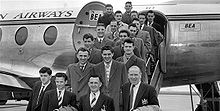A plaque at Old Trafford in honour of the players who died in the Munich air disaster
The team's chartered plane, an Airspeed Ambassador owned by British European Airways, left Belgrade on 6 February and stopped at Munich to refuel. Takeoff had to be aborted twice because of boost surging, a common problem in the "Elizabethan". The problem was caused by the fuel mixture being too rich, which caused the engines to over-accelerate: this problem was exacerbated by the altitude of the Munich airport.
The pilots were able to control the surging on the third takeoff attempt, but as they reached the V1 "decision speed" (after which it is unsafe to abort takeoff), the airspeed suddenly dropped. The aircraft left the runway, crashed through a fence and into a house. The left wing and the tail were ripped off, while the starboard side of the fuselage hit a fuel tank and exploded. Officially, the cause of the accident was build-up of slush on the runway, which caused the aircraft to lose speed, preventing it from achieving takeoff.
 |
| The Busby Babes in Denmark in 1955 |

